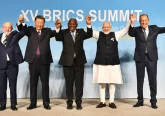Much has been said of the viral Kony 2012 campaign, ‘a film and campaign by Invisible Children that aims to make Joseph Kony famous… to raise support for his arrest and set a precedent for international justice’. The last page of the Invisible Children Kony 2012 action booklet reads, ‘Joseph Kony is the worst living criminal…He remains at large because he is invisible to the world. Few know his name, even fewer know his crimes. This year we are making Joseph Kony famous, because when he is, the world will unite for justice and demand his arrest’.
The Campaign
The campaign kicked off with the release of a (painfully narcissistic) 30-minute film that grossly oversimplifies the conflict and the actors. In what Aljazeera has called ‘a flash of glossy filmmaking’, the Kony 2012 video has become one of the fastest spreading viral videos, with over 100 million hits.
There is a colourful digital Kony 2012 action kit, complete with stickers to, according to the website, ‘slap onto your phone [or] laptop’. There is a bracelet, a pin, a pledge form, and three statistics (p. 14 of the Kony 2012 digital booklet). Everything is crimson coloured.
There is also a continually updated Crisis Tracker, with attack alerts and plotted/ heat maps of categorically defined crises (divided according to: civilian death, abduction, civilian injury, displacement, looting, LRA sighting, returnee, and media), complete with verification ratings and elaborate timelines (see image below).
The Reactions
The reaction among scholars, activists, journalists, bloggers and PanAfricanists was immediate in identifying the inaccuracies, exaggerations and oversimplifications, which addresses ‘crimes… from a bygone era’ as a tool to cultivate American military support (read intervention) for the Ugandan government, ‘a repressive dictatorial regime’ responsible for looting, rape and atrocities in the Democratic Republic of Congo. Adam Branch, has written of the Ugandan government’s ‘concentration camps’ in the Acholi region of Northern Uganda. Emmanuel Jal, a Sudanese musician and former child soldier says, ‘in a way [this Invisible Children campaign] robbed the dignity of the people of Northern Uganda’.
The film has also provided powerful fodder for comic derision. Seamus Duggan did a good job of assessing the skeptics’ rapid-fire employment of memes (visit www.quickmeme.com). A video produced by The Juice Media, called “Rap News 12: Yes We Kony”, is perhaps the most (depressingly) articulate comic response to the campaign. The video is a rap-spoof of a media interview with ‘General Baxter, representing AFRICOM’, probably a play on the American Union Army General Henry Baxter (1821 – 1873) who fought during the American Civil War.
General Baxter’s character raps: ‘… we desperately need a new dark-skinned Disney villain,/ so we can justify the defense budget of trillions/ in a never-ending quest to kill him./ And this time it’s African soil/ where we need to get embroiled and quick! Before China gets all the oil!’
In another scene from Rap News 12, General Baxter’s four-year old son, Gavin, walks into the room. This is a direct mockery of the Kony 2012 film, which uses the motif of fatherhood as a means of ‘explaining the history of the conflict.’ From Rap News 12,
General Baxter: ‘Now look what happens when I show Gavin a picture of an African. Who is this?’ [Red Alderton from Loughborough University helpfully pointed out that he actually holds up a photo of Carl Weathers in the film ‘Predator’ (see Red’s comment below this post)]
Gavin: ‘That’s a bad guy.’
General Baxter: ‘That’s right, and what do we do to bad guys?’
Gavin, ‘We use drones and armed forces to kill them and take their resources!’ [Gavin holds up a toy gun.]
Saviours and the Theme of White Parenthood in the Film
This scene in the Kony 2012 video, between Jason Russell, a founding member of Invisible Children, and his son, Gavin, starkly symbolises the lost opportunity of the film as a consciousness raising tool. In the scene, Jason discloses that he wants to explain the roots of the Ugandan conflict to his son. He explains, ‘So the thing is, my son Gavin…. he knows I work in Africa, but he doesn’t know what the war is about… or who Joseph Kony is, so I am going to explain it to him for the first time today.’ From the film:
Jason: ‘What do I do for a job?’
Gavin: ‘You stop the bad guys from being mean.’
Jason: ‘Who are the bad guys?’
Gavin: ‘Um… Star Wars people.’
Jason shows Gavin a photo of Joseph Kony, and explains: ‘Can I tell you the bad guy’s name? This is the guy, Joseph Kony… Joseph Kony, he has an army, okay? And what he does is he takes children from their parents and he gives them a gun and he makes them kill and shoot other people…. They don’t want to do what he says, but he forces them to do bad things. What do you think about that?’
When I watched the Kony 2012 video, I thought that perhaps Jason’s explanation to his son was a means of explaining the conflict in a manageable and graspable way for those who were unfamiliar. Unfortunately, the longer one watches the film, the more apparent it becomes that Jason seems to have no historical or socio-political context in which to place Joseph Kony or the conflict in Northern Uganda (for historical and political background on the conflict see these blog posts from Mahmood Mandami, Angelo Izama, and Michael Deibert).
A thorough explanation of the conflict is never provided. What follows this father-son scene is 25 minutes of alternately vilifying Joseph Kony and celebrating American social media activism.
With images of child soldiers and mutilated bodies flashing on the screen, Jason says in voiceover, ‘I could’t explain to Gavin the truth of what Joseph Kony does. Because the truth is, Kony abducts kids just like Gavin. For 26 years, Kony has been kidnapping kids into his rebel group, the LRA. Turning the girls into sex slaves and the boys into child soldiers. He makes them mutilate people’s faces and he forces them to kill their own parents.’ The theme of parental responsibility comes up over and over in the film, which begins with his son’s birth and a quick slideshow of his development during his first few years of life (we learn, for example that Jason enjoys dancing, being a ninja, making films and sand angels).
Jason feels responsible for ‘the boys’ in his life: his biological son Gavin as well as a Jacob, a former child soldier that Jason met while in Uganda. Unfortunately, Jacob is not humanised in the film in the same manner that Gavin is (although we do see him timidly petting a dolphin in one scene, encouraged by Jason to ‘not be afraid’).
One need only turn on the television to watch Machine Gun Preacher for a similar portrayal of a white character who travels to ‘Africa’ to ‘save the children’ against the backdrop of black-on-black slaughter, rape and torture which is never historically contextualised (see The Guardian’s Catherine Shoard’s critique of the white criminal-turned-saviour character of Sam in Machine Gun Preacher as ‘half saint, half psychopath’).
The message of empowerment in both films is the same: White people are empowered through the perceived act of ‘saving black people’ (note: I would not argue that Invisible Children are consciously constructing this message; they are trying to humanise the heroes of their story and the heroes of their story, as constructed by them, are white). Adam Branch was right when he wrote, ‘Kony 2012 and the debate around it are not about Uganda, but about America. Uganda is largely just the stage for a debate over the meaning of political activism in the US today.’ This is apparent in the campaign’s image of a donkey and an elephant (symbols for the two American political parties, see image above) merging under the slogan ‘one thing we can all agree on.’
So, sure, Kony 2012 comes from a place of human compassion. Jason is a man trying to leave a legacy for his son; to ‘make the world a better place.’ The film is a story about a white man and his white child, against which there is a backdrop of black faces: People to save and people to condemn, people which give the white actors meaning, purpose and moral up-righteousness. Kony 2012 is just a slight revision of a very old story.
Slacktivism
Invisible Children wants to save the world through military intervention in a conflict that they do not (seem to) understand (although they claim this is not the case, see their reaction to critiques of the film). The campaign implies that by making Joseph Kony a pop icon, he will be rendered visible and therefore apprehenable and that, ultimately, the war will stop and/or the world will be ‘a better place’ with him gone. To make this happen, one need only click ‘like’ on the campaign’s page or ‘slap’ a Kony 2012 sticker on a cellphone.
For this reason, the campaign has been criticised as a form of slacktivism (i.e. slacker/ lazy activism). This was the case with the Save Darfur Campaign, as well (although in this case the trend was to wear shirts that read ‘Save Darfur’), where the implication was that awareness of a conflict would lead to change (note that the Save Darfur has likewise been criticised for using faulty statistics and for misuse of funds).
Mareike Schomerus, Research Consortium Director at the London School of Economics, says of the Kony 2012 campaign, ‘If this is the future of activism, I am worried.’ So, the question remains: Does engaging hundreds of millions of people on the subject of conflict in central Africa ‘help’ despite not actually confronting the root causes and longterm consequences, i.e. can it be celebrated as step, however small, in the right direction for social media, political activism and raising awareness about African issues?
The answer in this case is a resounding no; this is because of the campaign’s dangerous appeal for military intervention. Mahmood Mandami writes, ‘will this mobilization of millions be subverted into yet another weapon in the hands of those who want to militarize the region further? If so, this well-intentioned but unsuspecting army of children will be responsible for magnifying the very crisis to which they claim to be the solution.’
The Good News?
The heated reactions and debates over the video indicate that social media users are increasingly critical of such campaigns. A quick visit to the Invisible Children Facebook page reveals the extent to which ‘ordinary people’ are raising pertinent questions about the organisation’s use of funds, agenda and purpose. The campaign can be credited for sparking heated debate about the use and scope of social media as well as for making people pause, ask questions and do some independent research about the origins and structural causes of conflict in central Africa.
Amber Murrey is a doctoral student in the Department of Geography at the University of Oxford.










3 Comments
Amber,
Fundamentally, I whole heartedly agree with your analysis of the subject and it was excellent to see a sceptical approach to this viral campaign arise as quickly as the campaign its self.
However, I have an observation to your analysis of the ‘Rap News 12: Yes We Kony’ video. You mention that the photo the general holds up is, the man himself, Joseph Kony. Yet, in reality this is a picture of Carl Weathers in the film ‘Predator’ from the Ailen/Predator franchise. This is a deliberate, dramatical tool used to ‘fool’ people into thinking its Kony, allowing one to highlight the little to no knowledge that many of the ‘bandwagon’ group have on the subject.
Other than this minor point, which you may or may not wish to point out, an excellent sceptical approach to a contentious subject.
Red Alderton,
Loughborough University
Dear Red,
Thanks so much for pointing out that the image is actually of Carl Wathers! It makes the “Rap News 12: Yes We Kony” video even more on-point and I had to watch it again after reading your post. I have made the necessary change in the original blog.
Best,
Amber
Amber,
Glad to help; For further reference:
http://www.buzzfeed.com/daves4/people-who-think-carl-weathers-is-joseph-kony
and
http://gawker.com/5891938/the-idiot-who-mixed-up-joseph-kony-and-predators-carl-weathers
Some people eh…!
Red